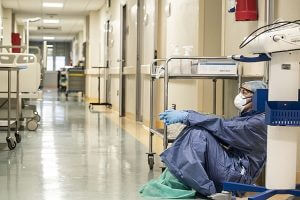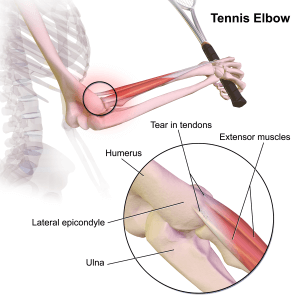Overview
Chronic obstructive lung disease (COPD), as the name indicates, is a long-term disease of the lungs characterized by obstructed/limited airflow.
It is a group of progressive lung disorders. The most common diseases included in it are emphysema and chronic bronchitis. Patients having COPD usually have both these conditions due to similar causes and risk factors.
In COPD, the chronic inflammation of the airway passages (bronchi and bronchial tubes) and lung tissue destruction narrow down the airways and decrease the recoiling ability of your lungs. This, in turn, causes progressive airflow limitation, and you may experience symptoms like cough, shortness of breath, etc.
According to the World Health Organization’s (WHO) report of 2019, COPD is the third leading cause of death worldwide. Centre for Disease Control and Prevention (CDC) says that COPD affects around 15 million US citizens, and every 4 minutes, an American dies of it.
Despite its wide prevalence, many people are unaware that they have it. The untreated disease worsens at a faster pace and can further lead to many other complications like heart problems, respiratory failure, etc.
Symptoms
As the disease is progressive and worsens gradually over time, you may observe mild symptoms, at first, like intermittent coughing and difficulty in breathing during exertion. When the disease becomes advanced, the symptoms become more constant and severe.
Early symptoms
In the early stages, the symptoms are very mild and are usually mistaken as the symptoms of the common cold as COPD mostly becomes evident in the winter season. These include;
- Occasional difficulty in breathing especially occurring after exercise or any other exertional activity
- Cough that is mild but recurrent
- A desire to clear your throat when you wake up in the morning
Late symptoms
In later stages, when the disease has progressed, signs and symptoms become more severe due to more lung damage. You may experience;
- Shortness of breath which occurs even at rest or on a mild activity like walking
- Chronic cough with or without sputum which may be white, yellow, or greenish in color
- Wheezing, a higher-pitched noisy breathing sound that particularly occurs when you exhale out the air
- Chest tightness
- Constant desire to clear your throat
- Frequent cold or respiratory infections
You may also observe weight loss, fatigue, and swelling of your feet, ankles, or legs, in the advanced stages of COPD.
Exacerbated Symptoms
Patients having COPD are prone to develop episodes of acute exacerbation. It usually occurs due to simultaneous development of lungs or respiratory tract infection.
During this episode, there is a sudden worsening of respiratory symptoms that is usually observed in the daily routine. The episode may remain persistent for several days.
Causes and Risk Factors
COPD is quite common in people above 40 years of age. The causes and risk factors of COPD are given below
- Tobacco smoking
- Passive smoking
- Air pollution
- Chronic inhalation of fumes from burning fuel used for cooking and heating
- Long-term exposure to chemicals and fumes at the workplace
- Asthma
Some people are genetically predisposed to develop COPD due to deficiency of a protein, known as alpha-1 antitrypsin which is responsible for the protection of lungs from the damage caused by inflammatory cells.
Diagnosis
Diagnosis of COPD is made based on symptoms, physical examination, and diagnostic tests.
- Clinical history: Your doctor will ask you about your symptoms, your family and medical history, history of smoking or any exposure to harmful chemicals and gases, etc.
- Physical examination: A complete examination of your chest area and extremities will be done, and your doctor will use a stethoscope to listen to your lungs as you breathe in and out.
- Pulmonary function tests: These tests are used to assess the function of your lungs. Spirometry is the most common test, in this regard, during which you take a deep breath and blow air into a tube connected to a small device, called a spirometer. It measures how much air your lungs can hold and how fast you can blow the air out.
Other tests may include a 6-minutes walk test, oximetry, etc.
- Imaging tests: X-ray and CT scan will be done to have a detailed look at the condition of your lungs, heart, and blood vessels.
- Arterial Blood Gas (ABGs) test: A sample of blood will be taken from your artery to measure the levels of oxygen and carbon dioxide. This will show how efficiently your lungs are adding oxygen and removing carbon dioxide from your blood.
- Other laboratory tests: These may include Complete Blood Count (CBC) test. It does not make the diagnosis but helps to find the cause of your symptoms and to rule other conditions like infection, anemia, polycythemia, etc. Alpha-1 antitrypsin levels can also be assessed.
Treatment
- Smoking cessation
- Supplemental Oxygen – If your blood oxygen level is low, you will be given supplemental oxygen through a mask or nasal cannula
- Pulmonary rehabilitation – it includes exercise training, education, nutritional advice, and behavioural counselling, aiming to improve patient’s physical function and psycological condition.
Medications
- Bronchodilators – these come in the form of inhalers and nebulizers. They help in relaxing the muscles of your airways and make breathing easier. They may be short-acting or long-acting. The choice is made on the severity of your symptoms.
- Inhaled corticosteroids – help in reducing inflammation and lower mucus production. They are usually given in combination with bronchodilators.
- Phosphodiesterase-4 inhibitors – are given orally in severe cases of COPD. They relax the airways and decrease inflammation.
- Theophylline –is given when other medications are not working. It relieves chest tightness and improves breathing. It also prevents the episodes of worsening COPD.
- Antibiotics and Antivirals – in case, you have developed a respiratory infection.
- Vaccination – to lower the risk of infections.
- Surgery – when other treatments does not work
- Bullectomy: Removal of large abnormal air spaces (bullae) from the lungs.
- Lung volume reduction surgery: In this procedure, small portions of damaged lung tissue are resected from the upper lobes of the lungs. This creates extra space for the healthy lung tissue to expand properly.
- Lung transplantation: It is also an option in certain cases.
Prevention
COPD can be prevented by the following things;
- Stop smoking.
- Also, avoid secondhand smoke (passive smoking).
- Use respiratory protective equipment if you work at a place where you are exposed to chemical fumes and dust.
- Regularly get your annual vaccination shots against pneumococcal pneumonia to minimize the risks of respiratory infections.
- Eat a healthy balanced diet.
COPD | NHLBI, NIH [Internet]. Nhlbi.nih.gov. [cited 26 July 2021]. Available from: https://www.nhlbi.nih.gov/health-topics/copd
Kim EK. Pathophysiology of COPD. InCOPD 2017 (pp. 57-63). Springer, Berlin, Heidelberg.
The top 10 causes of death [Internet]. Who.int. 2020 [cited 26 July 2021]. Available from: https://www.who.int/news-room/fact-sheets/detail/the-top-10-causes-of-death
Disease of the Week – COPD [Internet]. Centers for Disease Control and Prevention. [cited 26 July 2021]. Available from: https://www.cdc.gov/dotw/copd/index.html
Many Unaware They Have COPD [Internet]. WebMD. 2010 [cited 26 July 2021]. Available from: https://www.webmd.com/lung/copd/news/20100406/many-unaware-they-have-copd
Sapey E, Stockley RA. COPD exacerbations· 2: Aetiology. Thorax. 2006 Mar 1;61(3):250-8.
Brashier BB, Kodgule R. Risk factors and pathophysiology of chronic obstructive pulmonary disease (COPD). J Assoc Physicians India. 2012 Feb 1;60(Suppl):17-21.
Foreman MG, Campos M, Celedón JC. Genes and chronic obstructive pulmonary disease. Medical Clinics. 2012 Jul 1;96(4):699-711.
Agarwal AK, Raja A, Brown BD. Chronic obstructive pulmonary disease (COPD). StatPearls [Internet]. 2020 Jun 7.
Antus B. Pharmacotherapy of chronic obstructive pulmonary disease: a clinical review. International Scholarly Research Notices. 2013;2013.
Meek P, Lareau S, Fahy B, Austergard E. Surgery for chronic obstructive pulmonary disease. American journal of respiratory and critical care medicine. 2019 Aug 1;200(2):P5-6.
Corhay JL, Dang DN, Van Cauwenberge H, Louis R. Pulmonary rehabilitation and COPD: providing patients a good environment for optimizing therapy. International journal of chronic obstructive pulmonary disease. 2014;9:27.
Ambrosino N, Bertella E. Lifestyle interventions in prevention and comprehensive management of COPD. Breathe. 2018 Sep 1;14(3):186-94.
The content shared on the Health Literacy Hub website is provided for informational purposes only and it is not intended to replace advice, diagnosis, or treatment offered by qualified medical professionals in your State or Country. Readers are encouraged to confirm the information provided with other sources and to seek the advice of a qualified medical practitioner with any question they may have regarding their health. The Health Literacy Hub is not liable for any direct or indirect consequence arising from the application of the material provided.



